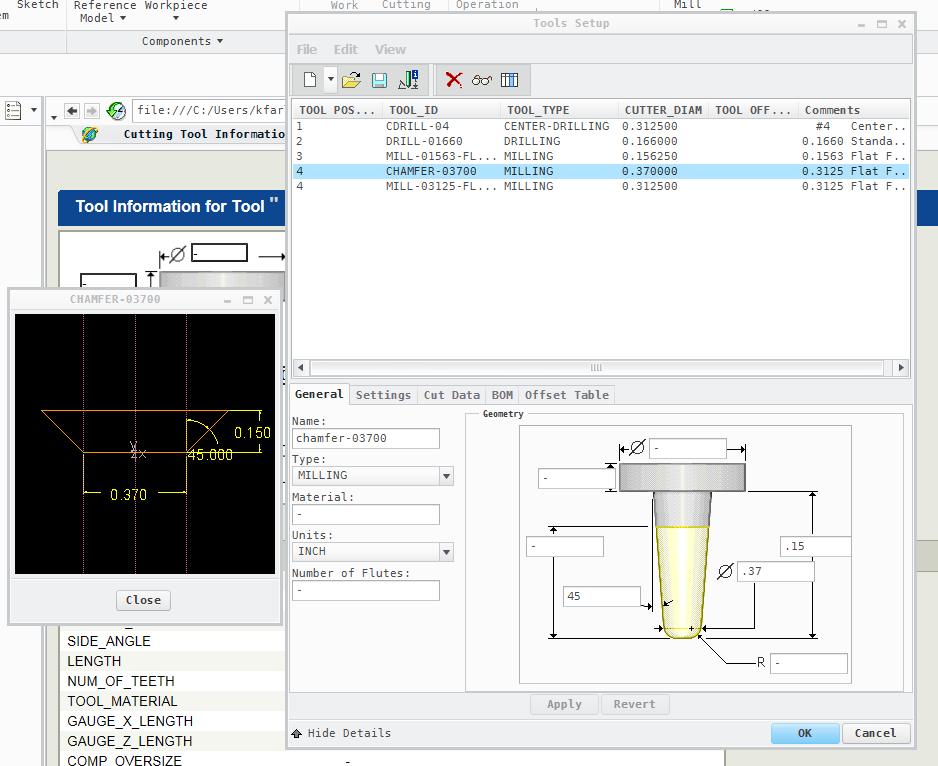Community Tip - Your Friends List is a way to easily have access to the community members that you interact with the most! X
- Community
- Creo+ and Creo Parametric
- 3D Part & Assembly Design
- Need help defining and using 45 degree face mill
- Subscribe to RSS Feed
- Mark Topic as New
- Mark Topic as Read
- Float this Topic for Current User
- Bookmark
- Subscribe
- Mute
- Printer Friendly Page
Need help defining and using 45 degree face mill
- Mark as New
- Bookmark
- Subscribe
- Mute
- Subscribe to RSS Feed
- Permalink
- Notify Moderator
Need help defining and using 45 degree face mill
When trying to define a tool for face milling, I am unable to find a tool that gives the option of having an angle associated with it, radius seems to be the option. 45 degree face mills are a fairly common tool, how can I define this tool? I am trying to face the part, and then mill the 45 degree angle in the part all with the same tool. Aside of being unable to define the 45 degree face mill under face milling, I am also unable to use a face mill for chamfer milling. The cam software that is being replaced does this job all with the same tool, and it is my job to replicate that. What would be the easiest way to do this in Creo?
Here the part needs to be face milled, and then using the same 45 degree face mill needs to mill the highlighted 45 degree chamfer.
This is the tool I am using.
Solved! Go to Solution.
Accepted Solutions
- Mark as New
- Bookmark
- Subscribe
- Mute
- Subscribe to RSS Feed
- Permalink
- Notify Moderator
I will probably be chastised for doing so, but I never use the specific "chamfer" toolpaths. If I need a chamfer I usually use a trajectory milling path. Unless the desired chamfer is on a non-planar surface, then I resort to surface milling with a ball end mill.
To define a tool for chamfering, I just use a standard mill. For example, the attached image shows the definition I use for my "favorite" chamfer tool, with the resultant geometry shown. The "trick" when programming the trajectory, as with most toolpaths, is what I specify for the cuts:
(1) I use the chamfer edge on the "top" surface to define the trajectory.
(2) I specify an offset for the path that is larger than the desired chamfer, i.e. if the chamfer is 0.025 inch, I offset more, maybe 0.040 or 0.050.
(3) I specify a Z axis shift (down) that is exactly the same as the offset decided in step (2).
This has worked for me for years. Hope it's somewhat helpful to you.

- Mark as New
- Bookmark
- Subscribe
- Mute
- Subscribe to RSS Feed
- Permalink
- Notify Moderator
I will probably be chastised for doing so, but I never use the specific "chamfer" toolpaths. If I need a chamfer I usually use a trajectory milling path. Unless the desired chamfer is on a non-planar surface, then I resort to surface milling with a ball end mill.
To define a tool for chamfering, I just use a standard mill. For example, the attached image shows the definition I use for my "favorite" chamfer tool, with the resultant geometry shown. The "trick" when programming the trajectory, as with most toolpaths, is what I specify for the cuts:
(1) I use the chamfer edge on the "top" surface to define the trajectory.
(2) I specify an offset for the path that is larger than the desired chamfer, i.e. if the chamfer is 0.025 inch, I offset more, maybe 0.040 or 0.050.
(3) I specify a Z axis shift (down) that is exactly the same as the offset decided in step (2).
This has worked for me for years. Hope it's somewhat helpful to you.

- Mark as New
- Bookmark
- Subscribe
- Mute
- Subscribe to RSS Feed
- Permalink
- Notify Moderator
I use a solid tool model for my 6" x 45 deg face mill.






